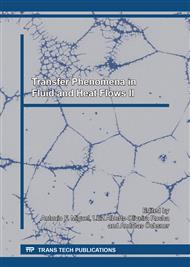[1]
P. Catalano, M. Wang, G. Iaccarino, P. Moin, Numerical simulation of the flow around a circular cylinder at high Reynolds numbers, Int. J. Heat Fluid Flow 24 (2003) 463-469.
DOI: 10.1016/s0142-727x(03)00061-4
Google Scholar
[2]
B. N. Rajani, A. Kandasamy, S. Majumdar, Numerical simulation of laminar flow past a circular cylinder, Appl. Math. Model. 33 (2009) 1228-47.
DOI: 10.1016/j.apm.2008.01.017
Google Scholar
[3]
S. Sarkar, S. Sarkar, Vortex dynamics of a cylinder wake in a proximity to a wall, J. Fluid Struct. 26 (1) (2010) 19- 40.
DOI: 10.1016/j.jfluidstructs.2009.08.003
Google Scholar
[4]
D. Sumner, Two circular cylinders in cross-flow: a review, J. Fluid Struct. 26 (2010) 849 – 899.
Google Scholar
[5]
Y. Kim, S. Lorente, A. Bejan, Constructal multi-tube configuration for natural and forced convection in cross-flow, Int. J. Heat Mass Transfer 53 (2010) 5121-5128.
DOI: 10.1016/j.ijheatmasstransfer.2010.07.053
Google Scholar
[6]
T. Bello-Ochende, A. Bejan, Constructal multi-scale cylinders with natural convection, Int. J. Heat Mass Tranfer 48 (2005) 4300 – 4306.
DOI: 10.1016/j.ijheatmasstransfer.2005.05.023
Google Scholar
[7]
T. Bello-Ochende, J. P. Meyer, O. I. Ogunronbi, Constructal multiscale cylinders rotating in cross-flow, Int. J. Heat Mass Transfer 54 (2011) 2568 – 2577.
DOI: 10.1016/j.ijheatmasstransfer.2011.02.004
Google Scholar
[8]
L. A. O. Rocha, M. das N. Gomes, A. F. Porte, M. M. Galarça, I. C. Acunha Jr., F. M. V. da Silva, L. A. Isoldi, E. D. dos Santos, Constructal design of turbulent forced convective flows over a pair of circular cylinders, Proceedings of Constructal Law Conference, Nanjing, China, 2013, p.174.
DOI: 10.5380/reterm.v11i1-2.62004
Google Scholar
[9]
G. M. Barros, M. S. Pereira, D. M. do Carmo, R. Cemin, L. A. Isoldi, L. A. O. Rocha, E. D. dos Santos, Geometrical optimization of mixed convective flows over triangular arrangement of cylinders, Therm. Eng. 15 (2) (2016) 84 – 91.
DOI: 10.5380/reterm.v15i2.62180
Google Scholar
[10]
A. Bejan, Shape and Structure, from Engineering to Nature. Cambridge University Press, Cambridge, UK, (2000).
Google Scholar
[11]
A. Bejan, S. Lorente, J. Lee, Unifying Construtal theory of tree roots, canopies and forests, J. Theor. Biol. 254 (2008) 529–540.
DOI: 10.1016/j.jtbi.2008.06.026
Google Scholar
[12]
A. Bejan, S. Lorente, Design with Constructal Theory, Wiley, Hoboken, (2008).
Google Scholar
[13]
A. Bejan, Z. P. Zane, Design in Nature. New York, Doubleday, (2012).
Google Scholar
[14]
M. K. Rodrigues, R. da S. Brum, J. Vaz, L. A. O. Rocha, E. D. dos Santos, L.A. Isoldi, Numerical investigation about the improvement of the thermal potential of an Earth-Air Heat Exchanger (EAHE) employing the Constructal Design method, Renew. Energy. 80 (2015).
DOI: 10.1016/j.renene.2015.02.041
Google Scholar
[15]
E. D. dos Santos, B. N. Machado, M. M. Zanella, M. das N. Gomes, J. A. Souza, L. A. Isoldi, L. A. O. Rocha, Numerical study of the effect of the relative depth on the overtopping wave energy converters according to Constructal Design, Defect Diffus. Forum. 348 (2014).
DOI: 10.4028/www.scientific.net/ddf.348.232
Google Scholar
[16]
G. V. Gonzales, E. da S. D. Estrada, L. R. Emmendorfer, L. A. Isoldi, G. Xie, L. A. O. Rocha, E. D. dos Santos, A comparison of simulated annealing schedules for constructal design of complex cavities intruded into conductive walls with internal heat generation, Energy. 93 (2015).
DOI: 10.1016/j.energy.2015.09.058
Google Scholar
[17]
T. Ko, K. Ting, Optimal Reynolds number for the fully developed laminar forced convection in a helical coiled tube, Energy. 31 (2006) 2142–2152.
DOI: 10.1016/j.energy.2005.09.001
Google Scholar
[18]
H. Najafi, B. Najafi, P. Hoseinpoori, Energy and cost optimization of a plate and fin heat exchanger using genetic algorithm, Appl. Therm. Eng. 31 (2011) 1839–1847.
DOI: 10.1016/j.applthermaleng.2011.02.031
Google Scholar
[19]
H. K. Versteeg, W. Malalasekera, An Introduction to Computational Fluid Dynamics – The Finite Volume Method, 1st Ed, Longman, England, (2007).
Google Scholar
[20]
S. V. Patankar, Numerical Heat Transfer and Fluid Flow, McGraw-Hill, New York, USA, (1980).
Google Scholar
[21]
FLUENT 6. 3. 26. User's Guide,. Fluent Inc, (2006).
Google Scholar
[22]
A. Bejan, Convection Heat Transfer, John Wiley, Durham, USA; (2004).
Google Scholar


